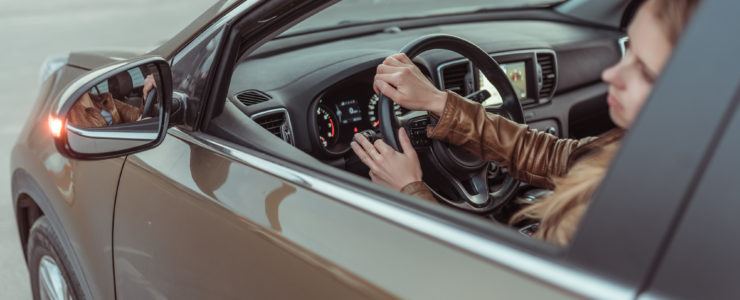
We have all been in there. Sitting at a traffic light waiting for the green light so that we can make a left hand turn through an intersection. Being a busy intersection, there are three turn lanes all allowed to make a left turn. The light turns green and the cars move forward (some faster than others).
Heading through the intersection we now find ourselves entering the street that is perpendicular to the one we were just on.
As we approach that new street, we try to find the lane that we are supposed to be in based on how we exited the last street. It really is not that difficult but sometimes we come across another driver to the side of us that gets confused and all of a sudden is either cutting us off as the turn is made or directly to our side about ready to crash into us. Or, perhaps you have been that driver.
In any case, it can be a dangerous predicament and really just comes down to paying more attention while driving the roads of Las Vegas (that rule of thumb is good regardless of the driving situation). There is a Nevada Revised Statue, one of the Rules of the Road, that pertains to this type of situation.
The law was written to help avoid this type of scenario described above which will help limit car crashes, injuries and getting you, the Nevada driver a traffic ticket. NRS 484B.400 sets forth all of the rules on how to position yourself when making a turn at an intersection.
It consists of five subpoints which we will break down so that you can have a better understanding of what all is involved.
These laws were all drafted and approved with deliberation as the intent from the Nevada lawmakers was to make the roads more safe within the state. If you are ever issued a ticket in Las Vegas, Henderson or anywhere else within the Silver State for that matter please reach out to us at Ticket Busters.
Our office is known throughout southern Nevada as the place to go to get help with your driving citation. Our legal team and professional staff will see your case from the start to the finish and our customer service is second to none. We will keep the communications line open so you never have any doubt about what the status is on your ticket and where it is in the process.
NRS 484B.400 is titled:
Required position and method of turning at intersections. If the driver of a vehicle intends to turn at an intersection and:
When Right Turns Are Allowed
The first subpoint to this statute discusses what to do and how to operate your vehicle when making a right hand turn. It reads:
1. The turn is a right turn, both the approach for the right turn and the right turn must be made from the right turn lane if the highway has a right turn lane as set forth in subsection 4 of NRS 484B.223, or must be made from the extreme right lane.
The first point that this section refers to is that right hand turns are only allowed if there is a right turn lane. Most streets will have that because by turning right, the driver does not impede traffic and really just goes along with the current flow.
There are parameters and rules for this though which is why a different NRS is referred to here. When a driver is approaching an intersection and needs to make a right hand turn, everything needs to be done from the far right lane. In other words, if you know you are turning right at the upcoming intersection, then you cannot be in the left hand lane and then veer off abruptly to the right hand lane to make your turn. You must already be in that lane and this is required for obvious reasons.
Even with this law in place, we still see people on the surface streets of Las Vegas making quick movements and lane changes to make a right hand turn. This subpoint also states another obvious fact and that is that all right hand turns need to be made from the lane on the right side. By not having this rule in play, many car accidents would likely happen. Because of this, if a law enforcement officer sees you make an action like this you can probably expect a traffic ticket.
How to Turn at Intersections
The second sub point to the statute pertains to situations where both roadways intersecting each other have flows of traffic heading in two different directions.
In other words, these are not one way streets:
2. Both intersecting highways are two-directional
The approach for a left turn must be made in that portion of the right half of the highway nearest the centerline thereof;
After entering the intersection, the left turn must be made so as to leave the intersection to the right of the centerline of the highway being entered; and
Except as otherwise directed by official traffic-control devices, simultaneous left turns by opposing traffic must be made in front of each other
This part really emphasizes how and where your car needs to be located when making certain types of turns. It provides specific instructions for not only making the turns but how to approach them and how to operate your vehicle while traveling through an intersection on your way to making a turn. It can be intimidating at a large intersection when making a left hand turn while other cars heading in your direction are also making a left-hand turn.
For a brief instance, it always appears that the cars will collide having a head on collision but to no avail, all cars continue veering left and that disaster is conveniently avoided.
That is a positive side to the rules within this statute where it states that the turns must be made in front of each other.
There is a caveat to that though and that is when there is signage present or a traffic-controlled device that dictates otherwise.
Additional Guidance on Making Left Hand Turns
Sub point number three provides instructions to follow when you are making a left hand turn from a road that has cars traveling in two different directions.
3. The turn is a left turn from a two-directional highway onto a one-way highway, the approach for the left turn must be made in that portion of the right half of the highway nearest the centerline thereof, and the turn must be made by turning from the right of the centerline where it enters the intersection as close as practicable to the left-hand curb of the one-way highway.
Number four is somewhat similar but draws a slight difference as it discusses how to navigate a turn from a road that only has cars moving in one direction. As with most other relevant verbiage, the left hand turn must be made as far left as possible which as stated before is to prevent obvious car crashes and havoc:
4. The turn is a left turn from a one-way highway onto a two-directional highway, the left turn must be made by passing to the right of the centerline of the highway being entered upon leaving the intersection, and the approach for the left turn must be made as close as practicable to the left-hand curb of the one-way highway.
The fifth sub point is the last one within NRS 484B.400 and provides a description on what to do when making turns from and to a one way street. The rules are not that much different than the others mentioned here previously but the lawmakers were thorough and wanted to describe every possible scenario.
5. The turn is a left turn where both intersecting highways are one-way, both the approach for the left turn and the left turn must be made as close as practicable to the left-hand curb or edge of the highway.
Issued a Ticket for Making an Improper Turn?
If you are caught making an improper turn on the streets of southern Nevada then you will probably be issued a ticket. In most cases, a violation of this manner will have a fine of $395. Along with having to pay that amount, a driver in Nevada can also expect to receive four demerit points against their drivers license.
If you take care of this on your own, without legal help then not much will change in regards to the penalties.
However, if you reach out to Ticket Busters, we will assign an attorney to work your case. Our attorney along with our professional team will work your case and will try to get your charges dismissed completely or lowered. By successfully reducing your charges to a non-moving violation, the fees are cut down and your insurance should not be impacted.
Call, email or drop by Ticket Busters to see how we can help.



